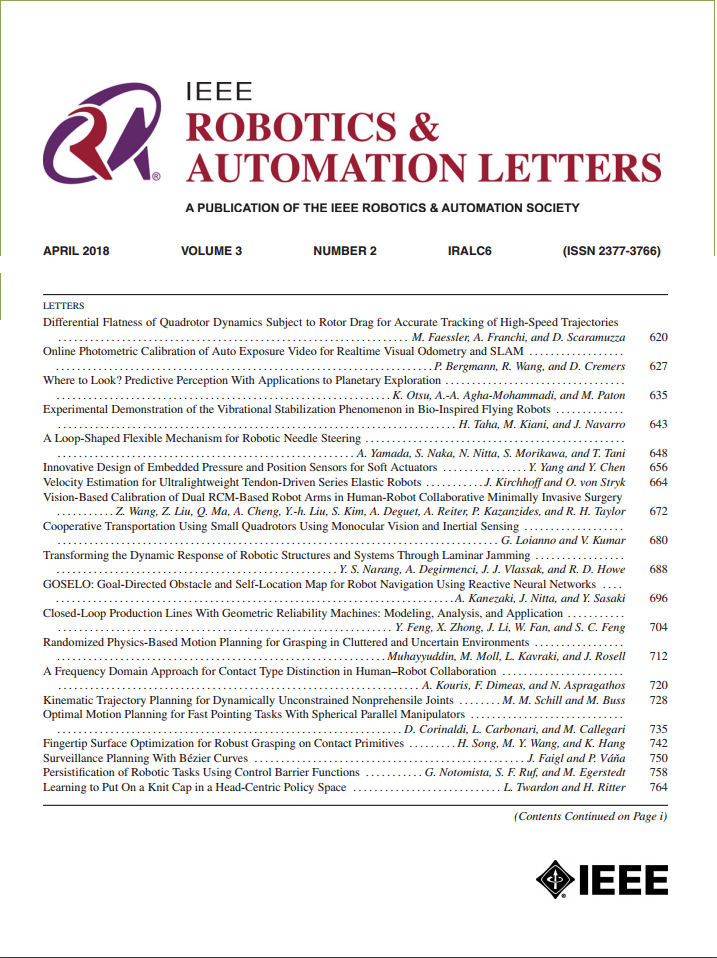Sensorless Force Imbalance Prediction Based on Visual Information for Robotic Ultrasound Scanning
IF 5.3
2区 计算机科学
Q2 ROBOTICS
引用次数: 0
Abstract
During robotic ultrasound examinations, maintaining pressure and angle control over the ultrasound probe is crucial for obtaining consistent images for an accurate diagnosis. Although force and torque sensors are commonly used for contact force monitoring, their accuracy can be influenced by sensor placement and system complexity. To address these issues, we propose a sensorless approach to estimate the contact force difference between the two sides of an ultrasound probe. Our proposed method utilizes a deep learning-based approach, specifically, a convolutional neural network–long short-term memory (CNN–LSTM) approach, that leverages sequential ultrasound images to estimate force differentials. Experiments were conducted using three tissue-mimicking phantoms and an in vivo human arm to train and evaluate the proposed approach. By varying the applied force difference on the phantoms and human arm, we achieved root mean squared error values of 0.501 and 0.553 N, respectively, in the contact force difference prediction. For performance assessment, we compared our proposed approach with a confidence map and various CNN–LSTM-based methods and demonstrated that our approach outperforms other approaches in terms of accuracy. The results indicate that our proposed method is effective for probe imbalance prediction without relying on physical sensors at inference time and can be deployed to control probes during robotic ultrasound examinations. Therefore, our sensorless approach offers a promising solution for more consistent and reliable robotic ultrasound scanning.基于视觉信息的机器人超声扫描无传感器力不平衡预测
在机器人超声检查中,保持超声探头的压力和角度控制对于获得准确诊断的一致图像至关重要。虽然力和扭矩传感器通常用于接触力监测,但其精度可能受到传感器放置和系统复杂性的影响。为了解决这些问题,我们提出了一种无传感器的方法来估计超声探头两侧的接触力差。我们提出的方法利用了一种基于深度学习的方法,特别是卷积神经网络长短期记忆(CNN-LSTM)方法,该方法利用连续超声图像来估计力差。实验使用三个组织模拟模型和一个活体人体手臂来训练和评估所提出的方法。通过改变施加在假体和人臂上的力差,接触力差预测的均方根误差值分别为0.501和0.553 N。对于性能评估,我们将我们提出的方法与置信度图和各种基于cnn - lstm的方法进行了比较,并证明我们的方法在准确性方面优于其他方法。结果表明,本文提出的方法可以有效地预测探针的不平衡,而不依赖于推理时的物理传感器,并且可以部署在机器人超声检查过程中控制探针。因此,我们的无传感器方法为更加一致和可靠的机器人超声扫描提供了一个有前途的解决方案。
本文章由计算机程序翻译,如有差异,请以英文原文为准。
求助全文
约1分钟内获得全文
求助全文
来源期刊

IEEE Robotics and Automation Letters
Computer Science-Computer Science Applications
CiteScore
9.60
自引率
15.40%
发文量
1428
期刊介绍:
The scope of this journal is to publish peer-reviewed articles that provide a timely and concise account of innovative research ideas and application results, reporting significant theoretical findings and application case studies in areas of robotics and automation.
 求助内容:
求助内容: 应助结果提醒方式:
应助结果提醒方式:


